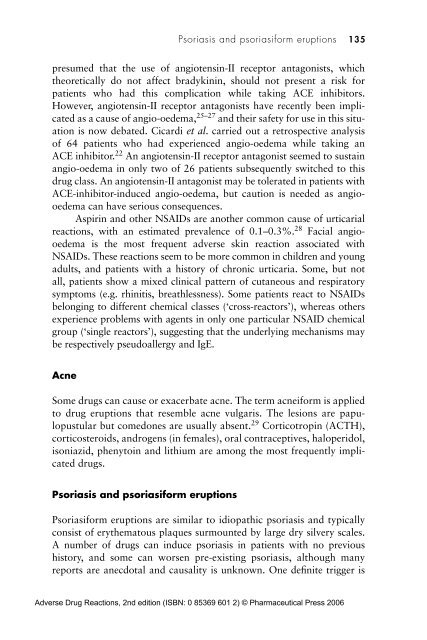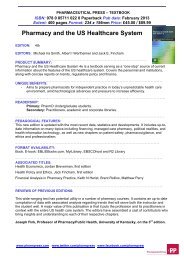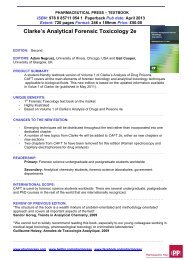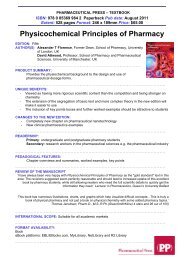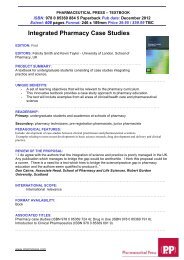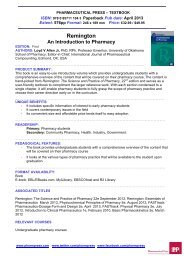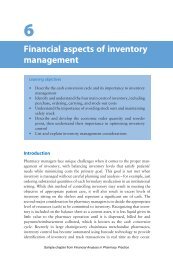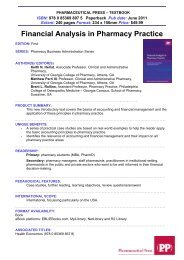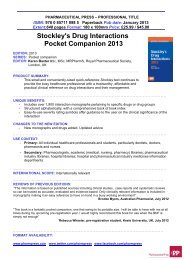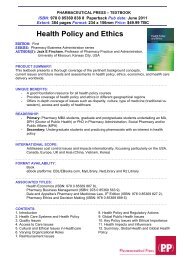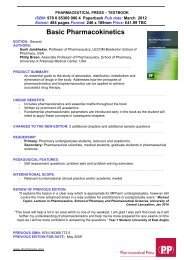Drug-induced skin reactions - Pharmaceutical Press
Drug-induced skin reactions - Pharmaceutical Press
Drug-induced skin reactions - Pharmaceutical Press
Create successful ePaper yourself
Turn your PDF publications into a flip-book with our unique Google optimized e-Paper software.
Psoriasis and psoriasiform eruptions 135<br />
presumed that the use of angiotensin-II receptor antagonists, which<br />
theoretically do not affect bradykinin, should not present a risk for<br />
patients who had this complication while taking ACE inhibitors.<br />
However, angiotensin-II receptor antagonists have recently been implicated<br />
as a cause of angio-oedema, 25–27 and their safety for use in this situation<br />
is now debated. Cicardi et al. carried out a retrospective analysis<br />
of 64 patients who had experienced angio-oedema while taking an<br />
ACE inhibitor. 22 An angiotensin-II receptor antagonist seemed to sustain<br />
angio-oedema in only two of 26 patients subsequently switched to this<br />
drug class. An angiotensin-II antagonist may be tolerated in patients with<br />
ACE-inhibitor-<strong>induced</strong> angio-oedema, but caution is needed as angiooedema<br />
can have serious consequences.<br />
Aspirin and other NSAIDs are another common cause of urticarial<br />
<strong>reactions</strong>, with an estimated prevalence of 0.1–0.3%. 28 Facial angiooedema<br />
is the most frequent adverse <strong>skin</strong> reaction associated with<br />
NSAIDs. These <strong>reactions</strong> seem to be more common in children and young<br />
adults, and patients with a history of chronic urticaria. Some, but not<br />
all, patients show a mixed clinical pattern of cutaneous and respiratory<br />
symptoms (e.g. rhinitis, breathlessness). Some patients react to NSAIDs<br />
belonging to different chemical classes (‘cross-reactors’), whereas others<br />
experience problems with agents in only one particular NSAID chemical<br />
group (‘single reactors’), suggesting that the underlying mechanisms may<br />
be respectively pseudoallergy and IgE.<br />
Acne<br />
Some drugs can cause or exacerbate acne. The term acneiform is applied<br />
to drug eruptions that resemble acne vulgaris. The lesions are papulopustular<br />
but comedones are usually absent. 29 Corticotropin (ACTH),<br />
corticosteroids, androgens (in females), oral contraceptives, haloperidol,<br />
isoniazid, phenytoin and lithium are among the most frequently implicated<br />
drugs.<br />
Psoriasis and psoriasiform eruptions<br />
Psoriasiform eruptions are similar to idiopathic psoriasis and typically<br />
consist of erythematous plaques surmounted by large dry silvery scales.<br />
A number of drugs can induce psoriasis in patients with no previous<br />
history, and some can worsen pre-existing psoriasis, although many<br />
reports are anecdotal and causality is unknown. One definite trigger is<br />
Adverse <strong>Drug</strong> Reactions, 2nd edition (ISBN: 0 85369 601 2) © <strong>Pharmaceutical</strong> <strong>Press</strong> 2006


